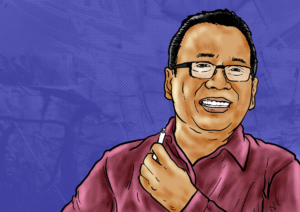The 2020 American elections were quite different from the 2016 one in terms of fake news circulation. This year, elections-related disinformation was not spurred mainly by Russia as it had been in 2016: instead, the disinformation came straight from the White House.
On Wednesday, Nov. 4, former president Donald Trump claimed that he had been elected as a United States president for his second term, regardless the fact that the elections commission had not finished counting all the electoral votes yet. He announced his “victory” in the East Room inside the White House in front of supporters and journalists.
A number of media outlets, apparently, have been led astray by this claim, reporting it as a “fact”, although many other media outlets such as Reuters was able to verify that Trump’s claim was “a false one”.
Subsequently, several mass media outlets had uploaded the victory claim video on YouTube, attracting hundreds of thousands of viewers. Yet, several media outlets eventually decided to remove the video, as soon as social media platforms like Facebook and Twitter had deleted postings from Donald Trump and his supporters.
Not just that, Facebook and Twitter even labeled these postings “misleading contents”. Facebook Newsroom’s Twitter account @fbnewsroom on Wednesday, Nov. 4 tweeted the following statement: “once President Trump began making premature claims of victory, we started running notifications on Facebook and Instagram that votes are still being counted and a winner is not projected. We’re also automatically applying labels to both candidates’ posts with this information”.
Once President Trump began making premature claims of victory, we started running notifications on Facebook and Instagram that votes are still being counted and a winner is not projected. We’re also automatically applying labels to both candidates’ posts with this information. pic.twitter.com/tuGGLJkwcy
— Facebook Newsroom (@fbnewsroom) November 4, 2020
Twitter has also blocked social media contents featuring other dubious Trump statements, including ones which accused foul play in the vote counting process. Between Nov. 3 and 6, Twitter erased 13 Tweets from Trump. Twitter has also marked the tweet as a “highly contentious and debatable content, which could potentially mislead people about not just the general elections but also other civil society processes”.
A journalism professor from George Washington University, Janet E. Steele, said that the actions taken by American news outlets, as well as those taken by the social media platforms such as Facebook and Twitter, to remove misleading information regarding the American elections, could be justified.
“When he was claiming his victory in the White House, Trump has in fact violated two principles. The first one is using the White House for public campaign purposes. Second, deceiving the public by announcing his victory long before the vote counting process is completely finalized,” Steele told jaring.id during an interview on Saturday, Nov. 7.
Despite the hard facts, apparently, Trump remained unmoved in his conviction that he had actually won the elections. Even when it became apparent that his political rival from the Democratic Party Joseph R. Biden, Jr. had already pocketed the biggest electoral votes (279 votes) on Nov. 7 – far exceeding the minimum target of 270 votes to win the elections – still, Trump continued to spread lies through his Tweets: “I’ve won the elections on a landslide”.
Trump has also tweeted that this year’s elections was a dishonest process, considering how elections observers had not been allowed to enter the vote counting room to observe the counting process firsthand. He also accused that millions of the ballot papers sent via postal services had been sent to the wrong address (it is important to remember that a lot of Democratic party supporters voted via postal services).
Twitter has immediately labeled both Tweets as problematic contents. Nonetheless, hundreds of thousands of people can still retweet the contents. Steele and a number of other political observers are also worried that Biden’s victory is not enough to bury Trumpism way of thinking. There’s a 4 million popular vote gap between Biden and Trump (Biden attracted 74 million votes; Trump, about 70 million) – sending us clear warning that we cannot underestimate the power of Trumpism.
Trumpism
According to Steele, Trumpism at its core is a race-based ideology.
“Trumpism often serves as a pull factor for the white working class who has no money and find themselves in a very difficult situation,” Steele said.
Furthermore, according to Steele, through his narratives, Trump has also made the white working-class Americans believe that they are indeed the true blue, native Americans – therefore discounting the rights of the real native Americans who had been exterminated by the white invaders, or the Mexicans, or the black people, or the Asian-Americans, or any other immigrants, to live in the United States of America.
“Racism and white supremacy are indeed core elements of Trumpism,” Steele asserted.
She said that the racial sentiment had already been popularly used since the Barack Obama era. At that time, not a few, handful of Americans had already made a fuss about the “native Americanness” of the African-American Obama. When Biden announced that he would run with Kamala Harris – an American woman of Jamaican and Indian descent – as a vice president candidate, a lot of questions about her Americanness have once again seeped into public consciousness.
“Trump has successfully brought this consciousness forth from a lot of people,” Steele continued.
This has also explained how Trump has won a lot of votes in regions with a white majority, although he could not come up with some decent public health programs.
“The only reason they supported [Trump] was racial sentiment; that’s all. They didn’t even think about their own political interests,” she said.
Borrowing a Marxist term, Steele referred to this phenomenon as a false consciousness.
Similarly, a University of Indonesia digital communication and cultural observer Firman Kurniawan referred to this situation as a collective unconsciousness. Both Steele and Firman agreed that the racial sentiment was indeed still alive and remained dormant inside the American psyche.
It was Trump who had been successful in shamelessly reviving the sentiment, starting from the time he was serving his term as an American president in 2016.
“Trump’s behavior mirrors the behavior of a segment of the American population,” Firman told jaring.id on Thursday, Nov. 5.
The racial sentiment got even stronger when Trump declared war on journalism, which happened simultaneously with the bankruptcy of local media outlets there, along with the propaganda aggressively spread on social media.
Trump and the strength of his presence on Twitter, according to Firman, are strong magnets for such sentiments to join forces. With an army of 88 million followers, Trump has been able to shape public opinion – an endeavor which the conventional media is struggling to achieve.
“Social media is the reality of today’s media,” Firman said.
Through the network of information which he has built through social media, referring to a concept by scholar Manuel Castells, individuals have formed a new identity, which is opposite to the American identity.
“Trumpism has successfully uncovered the roots of racism which all this time have been quite concealed among some segments of the American society. This movement also epitomizes an active resistance to values of pluralism and democracy which America has always espoused as its most supreme values,” Firman said.
The Trump supporters have built their trust on information which align with their personal convictions, which they have also shared in their personal networks, regardless of whether the information is fact-based or not. Many parties, including media outlets and their army of fact checkers, have also attempted to convince these people that they are in fact on the receiving end of wrong information, a message which falls on deaf ears only.
Trump’s tweets, which attempted to scare American voters using the ideas that immigrants/refugees from terrorist countries would soon flood the United States if Biden won the elections, are among the examples of how Trump “inserted” messages of white supremacy, which his followers are more than eager to profess.
“Joe Biden will increase the number of refugees from terrorist countries by 700 percent. The plan is to flood your community to slowly turn Michigan, Minnesota, Wisconsin and the entire Midwest into refugee camps. I protect your families and keep radical Islamic terrorists away from our country!” there went the tweet, which has been retweeted 34,000 times.
Northwestern University political observer Jeffry Winters, meanwhile, that the unedited and unfiltered fake information, which have been circulating wildly on the internet, has indirectly increased the number of communities which believe in conspiracy theories as well as the paranoid societies in the United Sates.
“Conspiracy [theory believer] and paranoid groups have always existed in America since a long time ago, but they’ve never existed in such a massive way,” Winters said during an online discussion that was organized two days before the United States organized the voting cycle of the elections.
For instance, Qanon is a group born out of the belief that America is actually run by people working in cahoots with secret society of pedophiliac devil worshippers. The group lends Trump their full support and they truly believe that Trump will ultimately exterminate the secret society.
According to Winters, social media outlets like Facebook and Twitter, which have their own algorithms, have contributed in their own way to the massive growth of these groups. This is why, during the American elections, Facebook and Twitter have been quite responsive in making sure that their platforms are not being used as highways to spread lies.
A lot of organizations in the United States have dedicated themselves to conduct fact checking. Yet, according to Steele, the problem gets even more complicated by the fact that people who spread disinformation are not the ones who typically bother to consult with some fact-checking sites first.
Media and democratic reform
Yet, what’s so interesting about America’s disinformation saga is how it has eventually pushed various media organizations to come up with innovative strategies to combat them. One way they are doing this is by creating a “truth sandwich”. No different from a sandwich, journalists can still convey politicians’ lies – especially those said by Trump – while still wrapping them around the real factual truth.
Steele gave an example that if Trump stated that the Democratic Party had just stone the votes when in fact there was no such thing happening, then the journalists could simply write the story like this:
“In an election that is honest and fair, president Trump said that the Democrats had stolen his votes, with no substantive proof supporting his statement,” Steele illustrated.
According to Steele, journalists resort to this strategy so they will not, unintentionally, reinforce the lie in public.
“This is a very positive development, how media organizations handle deceit[ful statements],” Steele said.
She said she hoped that the strategy that the American mass media was using could be replicated by the mass media in other countries, including in Indonesia. Yet, Steele still said that she was still concerned with the prospect that America would still take a very long time to heal the legacy of this elections-related polarization.
“The polarization has to do with the decline of local media/newspapers. It also has to do with Trump’s assertion that the media are liars,” Steele said.
The bankruptcy of local media has turned Americans into national media outlets. The problem is however, national media outlets have already been divided into each of their own political positions. This further sharpens societal polarization. The decline of public trust in media outlets has also become steeper since Trump accused the media as fake news spreaders.
When people have ceased to trust mainstream media, they quickly turn to social media. The problem is yet again, social media has algorithms which will expose users only to information which aligns with their personal interests.
“We really have no idea what will happen in the next three months to come. If Trump supporters mobilized their masses [to reject the results of the elections], the result is guaranteed to be terrifying,” Steele said.
A progressive senator from Vermont, Bernie Sanders, in his tweet dated Nov. 6, said he viewed Trump’s current actions – eroding the legitimacy of the elections – was part of attempts by demagogues (or more familiarly known as provocateurs) who want to destroy people’s faith in democracy while mobilizing people toward authoritarianism.
Indeed, Biden’s tasks once he gets into office will not be easy. In his victory speech, Biden mentioned that he could understand the discontent among Trump supporters. Yet, he called on all parties to just ease the tension while learning to listen to each other’s perspectives along the way.
He also said that he had already become determined to “eradicate systemic racism” and bring America together once again.
“I pledge to be a president who seeks not to divide, but to unify. Who doesn’t see red and blue states, but a United States. And who will work with all my heart to win the confidence of the whole people,” said Biden during his speech.
Winters, meanwhile, reminded us: no matter whoever won the elections, the United States needed to seriously reform its democracy.
“This is high time for America to become humbler and have a greater willingness to learn from the international world on how to adopt democracy,” he said.
Winters declined to assert that America’s democracy had failed. Yet, he acknowledged that America’s democratic practices were quite problematic, containing some anti-democratic elements: for instance, citizen representation in democracy was still lacking.
According to Winters, America still needs to reposition itself in the international democratic landscape.
“No longer to be patronizing, telling everyone from other countries what they need to do, meanwhile learn to truly understand what is going on in other countries,” Winters concluded. (Fransisca Ria Susanti)







